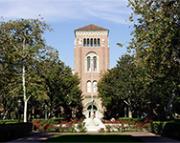20 Years Later, Remembering A Fortress In A City Filled With Chaos
Listen to the full audio story
- 2012-04-25lariotsheley.mp3

Twenty years ago on the night of Wednesday April 29, 1992 rioters were burning buildings and looting stores surrounding the USC campus. The infamous Los Angeles Riots began just minutes after a jury acquitted one Latino and three white LAPD officers accused in the videotaped beating of Rodney King, a black man. USC was used as a geographical reference point by the national news media for viewers unfamiliar with the Los Angeles area. The campus, however, remained unscathed. Meredith Goodwin was working in USC’s Development office at the time. "There was no damage at all to the USC campus, except one rock was thrown through the window of one of the security booths, and that's all," Goodwin said. "And it was attributed to the relationships that USC had built with the local community people, plus great security." USC’s director of undergraduate admissions at the time, Duncan Murdoch, was hoping for an incoming freshman class of about 2500 students. At the time of the riots only 1,200 had committed. A phone bank was set up at Kaprielian Hall and a small group of alumni and staff called about half of the 8,200 admitted freshmen and their parents to assuage any fears they might have about the campus’ safety. "My staff and I were, if we weren't directly dialing students we were getting incoming calls from students who'd been admitted or parents of students," Murdoch said. USC ended up only 200 students short of its incoming goal. "Well I think it was a major miracle that we ended up with that many [incoming] students in the end," Murdoch said. Students who could were encouraged to leave campus until the riots ended. Those who couldn’t were allowed to stay in campus housing and the Lyon Center. Campus cafeterias provided free food, barricades were set up at campus entrances and few were allowed in or out. With confusion about finals and the safety of returning to campus, the student newspaper, The Daily Trojan put out a special 8-page issue just days after the riots began. Mike Carlson, the incoming editor, toured the USC area with the paper’s photo editor. "You know the Ralph's I used to go get groceries at and it's just been completely torn apart. And you know Eddie was along shooting photos and I'm kinda talking to the manager of the store and I suppose if we wanted to we could have picked up a thing of sugar too and walked out the door too." Carlson believes it wasn’t an accident that USC was untouched by the riots. "At least talking to people in the community when I was out and about I got the impression that they saw USC as an asset, an institution that was doing things for the neighborhood, for the community and so why would they really want to destroy it or hurt it in any way," Carlson said. Many students were worried about going on campus to take finals. Though the University ultimately made finals optional, outgoing Daily Trojan editor Robin Rauzi remembers the students’ concern. "You would think that you could sort of put that aside when there's clearly a crisis of this magnitude going on around you, but at the same time you don't want to be the person who wasn't paying attention and therefore fails your psychology class," Rauzi said. There was speculation the graduation ceremony would be cancelled, but with national guard troops on the Doheny Library roof and helicopters in the sky, the commencement went on as scheduled. "I would see the graduating seniors in their robes and their parents were with them and they would go and they would pose with the national guard fellow behind them with a rifle slung over their shoulders," Goodwin said. "And at first that was a real shock to me and then I thought 'you know, imagine showing your grandchildren this photo.' Here you are graduating and there's a guy with a gun over his shoulder protecting you and thats what it was like when you were at school." With this year’s commencement just around the corner, we can consider ourselves lucky that students will be thinking more about their next step in life rather than the anger and violence around them.
Check out the future home of Annenberg student media:

Wallis Annenberg Hall
(opening Fall 2014)

